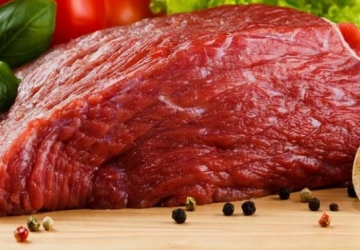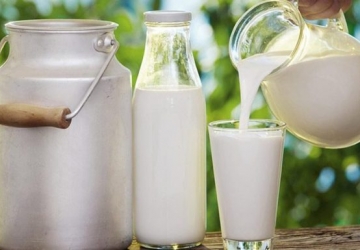
Communiqué on Determination of Health and Technical Conditions in the Importation of Beef Meat" prepared by the Ministry of
Food, Agriculture and Livestock has been published in the Official Gazette and entered into force. With the communiqué,
besides carcass meat, the door of the boneless meat import called lop meat opens.
Ali Ekber YILDIRIM
The government does not set limits on meat imports. After slaughter live animals and carcass meat, the lop meat, now known as
boneless meat, will be imported. For now, only Meat and Milk Association (ESK) will be able to import. "Communiqué on
Determination of Health and Technical Conditions in the Importation of Beef Meat" prepared by the Ministry of Food, Agriculture and
Livestock has been published in the Official Gazette and entered into force. With the communiqué, besides carcass meat,
regulations concerning the import of boneless meat, called lop meat, were also included.
The communiqué published in the Official Gazette dated October 7, 2017 envisages that the ESK and the private sector will
import carcasses and boneless beef by taking the Control Certificate after fulfilling the health and technical requirements.
However, the ministry will not allow for private sector imports for now.
The communiqué includes the following information about imports: "Cattle meat, meat and meat products dismantling and
processing facilities in accordance with ESK General Directorate and Veterinary Services No 5996, Plant Health, Food and
Feed Law, the meat store which is the storage place and the persons / organizations having the food factories or the
companies that will import on behalf of these enterprises. Beef will be in carcass or boneless meat, and this will be
mentioned in pro forma invoices.
The beef to be imported will be fresh, chilled or frozen. The person, institution or organization receiving the control
certificate is obliged to provide all the facilities together with the owner of the business so that the inspection and
control of the slaughtering, packing, packing and transportation of the official veterinarians appointed by the Ministry
in the enterprises in the exporting countries can be carried out in a healthy manner.
No import without inspection document
With the communiqué issued by the Ministry, the private sector allows the meat to be imported with the ESK. However, the
private sector needs to obtain the inspection certificate from the Ministry of Food, Agriculture and Livestock in order
to carry out this importation. The Ministry granted this certificate in 2012 and made imports possible. The ministry,
which has not issued any documents since 2015, says it will not give it in the context of the new communiqué issued. If
the private sector wants to bring meat with a political decision, the ministry will have to issue a check certificate.
Explanation of "no permit" from the Ministry
Muharrem Selçuk, General Director of Food and Control, Ministry of Food, Agriculture and Livestock, stated that meat and
milk institution is importing meat and said that private sector will not give "control document" necessary for import.
Selçuk reminded that the communiqué that allowed imports was first published in 2012 and that the private sector imported
meat on the basis of this communiqué at that time: In that communiqué, "Cattle meat, meat and meat products dismantling and processing facilities, meat sales with cold
storage, sale of cattle meat, meat and meat products by the General Directorate of NAC and Veterinary Services No. 5996,
Plant Health, Food and Feed Law are imported by the persons / organizations that own the places and the food factories or
by the companies that will import on behalf of these enterprises. ' there was provision. In 2012, the private sector
brought meat. But since 2015, we have not given control documents for private sector imports. We do not think to give a
new statement, "he said.
Import of lop meat entered the new communiqué
Food and Control General Director Muharrem Selçuk, and published in the Official Gazette dated February 19, 2012
"Communiqué on Determination of Health and Technical Conditions in the Importation of Cattle Meat" does not include
boneless meat. This communiqué covers only the regulation of carcass meat imports. The communiqué dated 7 October 2017
also covers the import of boneless (lop) meat. It is the same in both communiqués as to who can import. According to this,
"Cattle meat, meat and meat products cutting and processing facilities, meat sales places with cold storage facilities and
the people / organizations that have the food factories or the companies that will import on behalf of these enterprises".
ESK is importing from 3 countries
ESK continues to import beef. The ESK, which imports carcass beef from Poland, France and Bosnia and Herzegovina, also
imports boneless meat from Bosnia and Herzegovina with the decision of the Council of Ministers.
Manufacturer worried
The producers worry about opening the lop meat import after the carcass. Despite the government's announcement that
imports will be finished, producers who say that releasing all imports related to livestock will end domestic production:
"Lop meat import means to us not to produce. We will sell the flesh we produce. The country was delivered to the importer.
At the beginning, meat can be imported cheaply. But when the production is finished, the consumer will have to buy meat
more expensive. It was a very dangerous process. If the production is over, tomorrow even if you have money, you can not
find meat. The President of Turkey said, "We can not buy weapons with our money" and "We can not buy meat tomorrow".
Conditions to observe in import
In the Communiqué, which states that imported beef will be examined and controlled by the Ministry of Food,
Agriculture and Livestock in the exporting country and that importswill be allowed, the following conditions are
mandatory for import:
► The result of examination and control is obtained from the slaughterhouses where the national legislation has been
approved in terms of technical, health and hygiene conditions.
► Imports of meat cut from the slaughterhouses that are not suitable for the ministry personnel or cut before inspection
and control by the Ministry staff are not allowed.
► The cattle to be imported are obtained from cattle which are carried out according to the procedures determined by the Ministry
in accordance with the customs and customs of the country by the official veterinarian appointed by the Ministry.
► Bone-free meats to be imported are derived entirely from the complete carcass of an animal and are defined on the labels
on the packages from which region the carcass is derived.
► The individual identification numbers of the animals must be marked on the outer surface of whole, half or quarter
carcasses of the cattle to be imported or on the packaging of boneless meats.
► Meat that has been controlled and inspected to be imported to my country is kept in the same storage at different times
or in separate storage during cutting, shredding, packaging, labeling and loading stages. ► Meats that will not be imported to my country or meats of different animal species will not be kept in the same
warehouse or transportation.
► The veterinary health certificate indicating that cattle are obtained from healthy animals in the countries permitted
to import ministerial beef must be certified by the official veterinarian of the exporting country. ► The test certificate that the cattle where meat is obtained according to the conditions to be determined by the Ministry
shall be submitted to BSE (mad cow) during the actual importation. However, this document will not be sought for imports
from countries that have previously had no BSE cases and are in a negligible and controllable status according to the OIE
classification. ► A second inspection certificate will not be issued to the importer who does not fulfill the provisions of this
Communiqué. ► Health and technical conditions concerning the meat to be imported are determined by the ministry.





